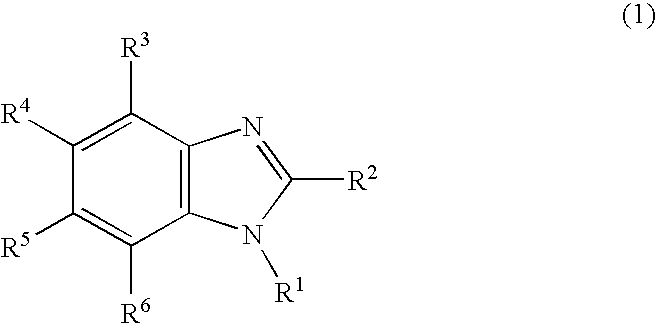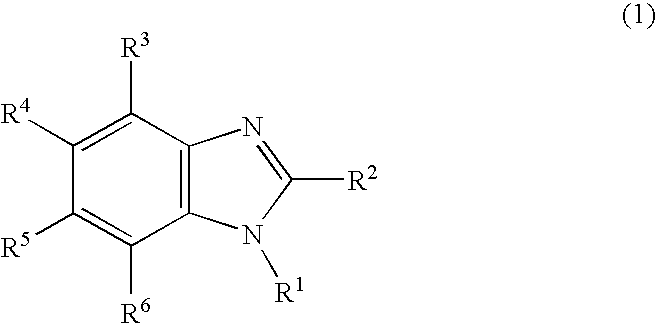Nitrogen-containing heterocyclic derivative having electron-attracting substituent and organic electroluminescence element using the same
a heterocyclic derivative and electron-attracting substituent technology, applied in the field of new materials, can solve the problems of marked deterioration in properties and inability to use devices in practical applications, and achieve the effect of excellent electron transport and great light emission efficiency
- Summary
- Abstract
- Description
- Claims
- Application Information
AI Technical Summary
Benefits of technology
Problems solved by technology
Method used
Image
Examples
synthesis example 1
Synthesis of Compound (1)
[0160]
(1-1) Synthesis of Intermediate 1
[0161]Into a reactor, 25 g (0.14 moles) of 4-chloro-3-nitrobenzonitrile, 56 g (0.68 moles) of sodium acetate and 13 g (0.14 moles) of aniline were placed, and the resultant mixture was stirred under heating at 120° C. for 8 hours and, then, dissolved into 300 ml of dichloromethane. The obtained solution was washed with water and a saturated aqueous solution of sodium chloride, successively, and dried with anhydrous magnesium sulfate. The solvent was removed by distillation under a reduced pressure, and the resultant residue was purified in accordance with the column chromatography (the solvent for the development: dichloromethane). The obtained crystals were washed with methanol, and 30 g of Intermediate Compound 1 was obtained. The yield was 92%.
(1-2) Synthesis of Intermediate 2
[0162]Into 300 ml of tetrahydrofuran, 30 g (0.13 moles) of Intermediate 1 was dissolved. While the resultant solution was stirred at the room t...
synthesis example 2
Synthesis of Compound (2)
[0165]
(2-1) Synthesis of Intermediate 4
[0166]Into a reactor, 8 g (0.038 moles) of 4-fluoro-3-nitrobenzotrifluoride, 13 g (0.16 moles) of sodium acetate and 3.6 g (0.039 moles) of aniline were placed, and the resultant mixture was stirred under heating at 120° C. for 8 hours and, then, dissolved into 100 ml of dichloromethane. The obtained solution was washed with water and a saturated aqueous solution of sodium chloride, successively, and dried with anhydrous magnesium sulfate. The solvent was removed by distillation under a reduced pressure, and the resultant residue was purified in accordance with the column chromatography (the solvent for the development: dichloromethane). The obtained crystals were washed with methanol, and 10 g of Intermediate 4 was obtained. The yield was 93%.
(2-2) Synthesis of Intermediate 5
[0167]Into 60 ml of tetrahydrofuran, 5 g (0.017 moles) of Intermediate 5 was dissolved. While the resultant solution was stirred at the room tempe...
example 1
Preparation of an Organic EL Device Using the Compound of the Present Invention for the Electron Injecting Layer
[0170]A glass substrate (manufactured by GEOMATEC Company) of 25 mm×75 mm×1.1 mm thickness having an ITO transparent electrode (the anode) was cleaned by application of ultrasonic wave in isopropyl alcohol for 5 minutes and then by exposure to ozone generated by ultraviolet light for 30 minutes. The cleaned glass substrate having the transparent electrode line was attached to a substrate holder of a vacuum vapor deposition apparatus. On the surface of the cleaned substrate at the side having the transparent electrode line, a film of N,N′-bis(N,N′-diphenyl-4-aminophenyl)-N,N-diphenyl-4,4′-diamino-1,1′-biphenyl (referred to as a TPD232 film, hereinafter) having a thickness of 60 nm was formed in a manner such that the formed film covered the transparent electrode. The formed TPD232 film worked as the hole injecting layer. On the formed TPD232 film, a film of 4,4′-bis[N-(1-na...
PUM
 Login to View More
Login to View More Abstract
Description
Claims
Application Information
 Login to View More
Login to View More - R&D
- Intellectual Property
- Life Sciences
- Materials
- Tech Scout
- Unparalleled Data Quality
- Higher Quality Content
- 60% Fewer Hallucinations
Browse by: Latest US Patents, China's latest patents, Technical Efficacy Thesaurus, Application Domain, Technology Topic, Popular Technical Reports.
© 2025 PatSnap. All rights reserved.Legal|Privacy policy|Modern Slavery Act Transparency Statement|Sitemap|About US| Contact US: help@patsnap.com



